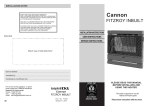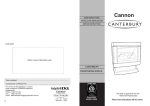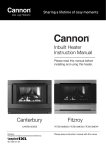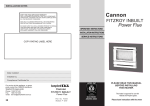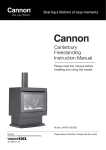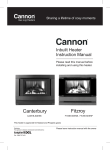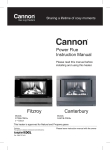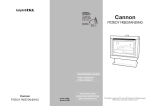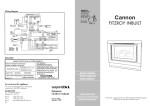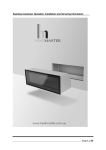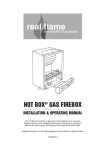Download Cannon CANTIB Operating instructions
Transcript
Data label Cannon USER INSTRUCTIONS INSTALLATION INSTRUCTIONS Stick copy of data label here! SERVICE INSTRUCTIONS Date installed: ........................................ Compliance Certificate No ......................... CANTERBURY INBUILT MODELS For service to this appliance or spare parts contact the CANNON distributor: Sampford IXL (spare parts) PLEASE READ THIS MANUAL BEFORE INSTALLING AND USING THIS HEATER. Cannon Phone: 1300 727 421 Fax: 1300 727 425 email: [email protected] Part No: F2901 Revision K- 2010 24 Gmk10025 AS4553:2008 This heater is approved for use with Natural and Propane gases. Please leave instructions with the owner Contents Contents Warranty ? 2 8. 3 Safety warnings ? What to do if you smell gas ? Warnings ? Standards 4-5 User instructions ? Operating instructions ? Cleaning ? Flame characteristics 6-8 Heater specifications 9. 16-17 Fuel bed and log installation Gas control ? Gas pressure point ? Gas pressure adjustment Installation tips 2 10-15 correct polarity. Do not use an extension cord. Check polarity in the electrical supply lead to appliance. • Check that the sense electrode is in the flame. • Check that appliance is earthed correctly. A check between the earth pin on the plug and an unpainted part of the appliance should see a resistance of 0.1 ohms. • The gas valve should open at the same time as the igniter sparks. If there is no gas to the burner when this occurs check the solenoid coils for continuity. • Check that the gas pressure is present at the test point when the spark is being generated. • Check that there is gas to the inlet of the gas control. Fuse blowing. • Test the flame for correct ionisation signal. Connect a multiple in series with flame rod and set the function to measure micro-amps. The module will go into lockout if the flame current sensitivity is less than 0.5 micro-amps. The approximate signal strength on high flame is about 10 micro-amps and on low 4 micro-amps. The signal strength will fluctuate but should be greater than 1.5 micro-amps at all times. Take precaution because the ionisation probe can have a high negative voltage and can cause shock. • If the fuse continues to blow check the solenoid coils for signs of them being shorted. • Check the fan and wiring for short circuit. Connections Terminals 5, 6 and 7 at the module 12 way connector are bridged. 19 20-21 Trouble-shooting 22-24 Connections Electric wiring diagram Data plate Date installed, Compliance Certificate No. For service to this appliance 11. 17-19 Service instructions ? General ? To replace the primary glass ? To replace the gas control ? To replace the fan ? To replace the electronic controller ? To remove the burner and electrodes ? To check pressures ? ? ? ? ? Appliance lights but goes into lockout Clearances Installation into a masonry/brick or mock fireplace Installation WITH a flue connected Installation WITHOUT a flue connected Sealing Gas connection Log installation ? No gas to burner. • Check that the wall socket to the appliance has 9 10. Installation instructions ? ? ? ? ? ? Sparks, ignites on low flame then extinguishes after 10 seconds. Continues to spark during flame presence. Distributor Terminal 10 at the module 12 way connector is the active supply via the red wire. Terminal 11 at the module 12 way connector is the neutral supply via the blue wire. Terminal 12 at the module 12 way connector is the earth connection via the green/yellow wire. 36 Terminal 12 at the module 2 way connector is the neutral connection via a brown wire which is joined into the rectifier cable then into the 8 way switch connector blue wire. Terminal 14 is an active connection at the module 2 way connector via a white wire into the 8 way switch connector. This is active only when the flame is sensed. 23 Trouble-shooting (Do not modify this appliance) To check the operation of the electronic (module) controller (Techrite ) you will require a digital multimeter with the functions to measure AC/DC voltage, continuity, resistance and micro-amps. Warranty The benefit conferred by this warranty are in addition to all other rights and remedies in respect of the product that consumers have under the Trade Practices Act and similar laws of the States and Territories. It is critical that the appliance is earthed and that the active and neutrals are not reversed. Item No 1. Check No ignition when appliance is turned on. 2. Power present but appliance not operating. 3. After resetting the module and appliance is still not operating. 4. If the fuse is O.K. and still appliance not operating. 5. 6. 7. 22 Confirm spark is produced when heater is turned on. If no spark being produced. Spark is being produced but not at burner. Action • Check 240 volts power to heater in incoming plug connector. • Check operation of room circulating fan. If the fan has malfunctioned, or is faulty, the fan pressure switch will recognise this and not allow the heater to function. • Check operation of fan pressure switch. If room circulation fan is operating the pressure switch should energise and allow ignition sequence. • If there is power to the brown wire in the 8 way switch connector the module may be in lockout mode. To reset the module turn off the power supply for 10 seconds and then turn the power on again. • Check the external 2-A fuse in the loom. • Check other connections are in place. • If the last checks are correct the ignition electrode should spark at the same time as the gas control solenoid valves open. At this point the spark electrode will activate for up to 10 seconds maxi mum until the flame has been established. Terminal 13 (white wire into the 8 way switch connector) will be energised as soon as the flame has been sensed. • A blue spark can be seen when the heater ignition process starts. Ensure spark is present between electrode and burner. • The spark gap should be 4 - 6mm. •Check that spark lead is connected into module. • Check the continuity of the HT cable. • Check that there is no short circuit to earth and spark gap is correct. (Refer figure 36). A positive check is to use a jumper wire and connect one end of the earth and hold the other end with insulated pliers 4mm from the spark generator on the module. If there is no spark to earth then change the module. • Listen for cracking sound. The spark is misdirected. Check the spark ceramic insulator for signs of cracks. We warrant this Cannon appliance to be free of defects in materials, workmanship and manufacturing to the original purchaser for 2 years, (10 years on the heat exchanger) from the date of original purchase. We will, at our option and subject to the terms of this warranty, repair or replace free of charge this Cannon appliance or any component part, which upon examination by us or our repair agent is found to be defective in materials, workmanship or manufacturing. However, this warranty does not cover any consumables (if any). The purchaser must present the original purchase receipt to us when making any claim under this warranty. This warranty will not apply if: (i) a compliance label or serial number (as the case may be) has been removed from the appliance or rendered illegible; (ii) the appliance has been subject to misuse, abuse, accident, incorrect installation or non-domestic use; (iii) the appliance has been modified, tampered with or repaired by a person other than our authorised repair agent; (iv) the appliance is re-installed/relocated during the warranty period. The purchaser is responsible for all travelling expenses if the purchaser requests any repair be carried out at a place outside areas normally serviced by our repair agents. Should you require service on this appliance, please contact our service department on 1300 727 421. Enter the details of the date installed and the Compliance Certificate number in the appropriate area on the rear page of this manual. Don’t risk your appliance warranty Only a licensed person will give you a Compliance Certificate, showing that the work complies with all the relevant standards. And only a licensed person will have insurance protecting their workmanship for 6 years. So make sure you use a licensed person to install this appliance and ask for your Compliance Certificate to ensure the manufacturers appliance warranty will be honoured. Distributor This appliance is designed, manufactured and distributed by: Tel: 1300 727 421 3 Safety Warnings Please read this manual before installing and using the heater. To remove the heat exchanger What to do if you smell gas Please refer to manufacturer. Contact details page 24 of this manual. 1. Turn OFF the main gas supply. 2. Extinguish any open flame. 3. Open windows. 4. Do not touch electrical switches. 5. Do not use your telephone. 6. Call your gas supplier immediately from a neighbour’s phone. To replace the burner and spark/sense electrodes 3. Due to high temperatures the room heater should be located out of traffic and away from: EARTH • Furniture and draperies, • Combustible materials, • Gasoline and other flammable liquids, 4 COMMON BLACK RED NO PRESSURE SWITCH P/No. F3327 RED BLACK RED TH2 FUNCTION CONTROL MODULE P/No. F3604 H ORANGE GREY M BLUE BLUE L BROWN BROWN FUSE 1.5 AMP PURPLE F3663-5_A MOD2 PURPLE GREY Children should be supervised to ensure that they do not play with the appliance. EARTH COMMON MOD1 WHITE 240 V MAINS PLUG WIRING DIAGRAM 7. Do not place articles on or against this appliance. Do not use or store flammable materials near this appliance. Do not spray aerosols in the vicinity of this appliance while it is in operation. Do not modify this appliance. RED IGNITION MODULE F3434 This appliance is not intended for use by persons (including children) with reduced physical, sensory or mental capabilities, or lack of experience and knowledge, unless they have been given supervision or instruction concerning use of the appliance by a person responsible for their safety. 6. Never attempt to burn paper or any other material in the heater. BLACK WHITE ORANGE temperature and should take care to avoid burns or clothing ignition. MODULATING VALVE F3691 YELLOW/GREEN 5. Children and adults should be alerted to the hazard of high surface HIGH BRN / HIGH FAN E N A 4 WAY * At the owner’s discretion curtain clearance can be less than 900mm as long as they are restrained from the front, top and sides of the heater. The manufacturer takes no responsibility if curtain clearance is less than 900mm and not restrained. SHEATHED CABLE MED BRN / MED FAN COILS FLAME SENSOR BLUE 4. Keep curtains*, clothing, furniture and other flammable materials at least 900mm from front and sides of the heater. SPARK ELECTRODE YELLOW/GREEN Do not place clothing or other flammable material on or near the heater. SWITCH ON/OFF LW BRN / LW FAN BRN BLK W YELLOW/GREEN 6 WAY CONNECTOR 2. Do not build the heater into bookcases or walls. Install only in locations as referred to in these installation instructions. 8 WAY CONNECTOR 1. Improper installation, adjustment, alteration, service or maintenance can cause injury or property damage. Refer to other sections of this manual for correct procedures, or consult with place of purchase, a licensed plumber, a gas supplier or the CANNON distributor listed in this manual. 6 WAY CONNECTOR Warnings 1. Refer pages 13 and 14, steps 7 to 11, of the installation instructions. 2. Remove the logs from the burner chamber. 3. Remove the burner chamber front, 4 screws. 4. Disconnect the 16mm nut at the outlet of the gas control. 5. Disconnect the spark and sense electrodes from the ignition (module) device. 6. Remove the burner fixing brackets (2) from the RH and LH side of the burner. Lift the burner assembly upward and carefully remove from the burner chamber. 7. Replace in reverse order checking location of spark/sense electrodes, refer page 23, figure 36. Spark gap between electrode and surface of burner is 4 - 6mm. Check for gas tightness. For log placement refer page 16 of this manual. A BLUE N BLUE N BROWN BLACK WHITE BLUE ROOM FAN - F3594 21 To replace the room circulation fan 1. Remove the lower front cover by unscrewing two M5 screws through the air intake slot. Refer page 13, figure 16, of the installation instructions. 2. Remove the screw retaining the bracket mounting the valve controls ( white box) Move the bracket and controls to the front of the heater. 3. Disconnect the fan plug from the plug carrier. Remove the two M5 wing nuts which locate the fan to the fan chamber underside. Lower fan from male thread. 4. Disconnect the silicon tubes from the fan pressure switch, rotate the fan scroll 90° and remove the silicon tubes from the venturi located in the fan scroll. Remove fan from fan chamber. 5. Replacement fan. Remove the venturi and bracket from the fan removed from the heater. Insert and secure the venturi and bracket on replacement fan. 6. Insert fan into fan chamber ensuring that the venturi is not disturbed. Replace silicon tubes onto the venturi and locate fan onto male thread. Secure with M5 wing nuts, ensuring rubber buffer locates over thread. 7. Replace silicon tubes onto fan pressure switch and reconnect fan plug into plug carrier. Note :correct connection of pressure hoses is important. 8. Test operation of room circulation fan and fan pressure switch - turn heater on high burner, low fan. The room fan should operate instantaneously and a possible 5 - 10 second delay for the fan pressure switch to energise dependant on room temperature. The burner should now operate on high setting. 8. If removed, the glass window must be put back onto the unit prior to operating the heater. 9. Installation and repairs should be performed by a licensed service person only, refer to back of brochure for service number. 10. For installation into a non-combustible fireplace, i.e.: masonry or brick or into a mock fireplace, i.e. timber or plasterboard, the chimney and base should be of sound construction and be free from cracks and holes (to ensure that sufficient flue draught can be generated). Note: when installing into a mock fireplace a mock fireplace installation kit must be used. 11. The heater must be properly installed in a working chimney or connected to a venting system. Operation of this heater, when not connected into a working chimney or a properly installed and maintained venting system can result in carbon monoxide (CO) poisoning and possible death. 12. Testing the effectiveness of the flue. Before testing the flue confirm air vents are unobstructed. If an exhaust fan or other heating appliances are present switch them on. This is to test that there is no interaction between the Cannon heater and other appliances. Refer AS5601. For ‘air movement not to affect appliance’ see clause 5.3.1. For ‘air supply to appliance’ see clause 5.4.1. For ‘ventilation requirements’ see clause 5.4.3. 13. The appliance should be inspected prior to use, with regular inspections (annually) to be made by a licensed service person. It is important that circulating air passageways of the appliance be kept clean, dirt and lint free, for a safe and efficient operation of the heater. 14. On first lighting your heater a smell may occur due to its new condition. This is quite normal and will disappear after a few hours use at the maximum control position. To + side of pressure switch To -ve side of pressure switch To replace the fan pressure switch 1. Remove the lower fan cover by unscrewing two M5 screws through the air intake slot. Refer page 13, figure 16, of the installation instructions. 2. Remove the connecting wiring (3) from the pressure switch. 3. Remove the silicon tube from the pressure switch. 4. The pressure switch is secured onto the rear of the fan chamber housing by four M4 screws. Remove screws. 5. Replace in reverse order. 20 Important: When this heater is operating the mesh guard/glass front is hot. The mesh guard, or glass front, fitted to the heater conforms to Australian Standards requirements. The guard is fitted to this appliance to reduce the risk of fire or injury from burns and no part of it should be permanently removed. For protection of young children or the infirm, a secondary guard is required. Standards This appliance meets the following standards: Standards Australia: AS/NZS 3100 AS 5601 AS 4553:2008 5 User instructions Service instructions (Do not modify this appliance) General Operating instructions 1. Service work to be carried out by an authorised service person only. 2. Unplug from wall socket or turn off power at main switchboard if heater is hard wired. 3. Always shut off the gas supply and ensure that the heater is cool before commencing any service operations. 4. Always check for gas soundness after servicing. 1. Plug the power cord into the wall socket and turn on the power to the heater, see figure 1. Refrain from using an extension cord. To replace the primary glass 1 1. Refer pages 13 and 14, steps 7 to 11, of the installation instructions. Refit glass and replace in reverse order ensure the inside surface of the glass is clean and free from finger marks. To replace the outer glass 2. For control lay-out refer to figure 2 1. Remove the outer glass, refer page 13, fig 15. 2. Loosen bottom glass frame and remove top glass frame. 3. Replace glass and refit in reverse order. Note: ensure the inside surface of the glass is clean and free from finger marks. ON/OFF button When there is power to the heater but it is on standby mode a red LED will blink intermittently behind this button. To turn heater on press the ON/ OFF button. There will be a 5 second delay before the burner ignites. At this setting the burner is on low flame / low fan for 3 minutes. During the ignition process the red LED will glow. ON / OFF To replace the gas control LOW 1. Remove the lower front cover by unscrewing two M5 screws through the air intake slot. Refer page 13, figure 16, of the installation instructions. 2. Unplug the cables from the gas control and disconnect the earth connection. 3. Disconnect the gas inlet (1/2” compression nut) connection at entry gas control and the 16mm nut at the outlet of the gas control. 4. Remove the three M3 screws from the cradle retaining the gas control. 5. Remove gas control. 6. Replace gas control in reverse order and check for gas tightness MEDIUM Note: check the gas pressure on high and low burner settings. Refer ‘gas control’, pages 13 and 14 The red LED will fade out after 30 seconds when the ignition process is complete. Pressing the heat setting buttons will set the heater to HIGH , MEDIUM or LOW heat. The fan is set to a corresponding speed for each setting. To turn the heater off press the ON OFF button. Ignition module HIGH If the burner fails to ignite, wait 20 seconds and then press the ON OFF button. In case of power failure, when the power returns, wait 20 seconds for any unburnt gas to vent and start reignition by pressing the ON OFF button. 6 Mounting bracket 2 To replace the ignition (module) device 1. Unplug wire connectors from ignition module. 2. Remove module mounting bracket by removing mounting screw. 3. Using pliers bend tabs so that module can come away from the mounting bracket. 4. Replace ignition device in reverse order. 19 Operate the heater on HIGH, MEDIUM and LOW burner settings. The flame should be stable with no lifting from the burner and the logs should glow after approximately 15 minutes of operation on HIGH burner. If the flame is unstable: • Check that the burner is located correctly. • Check that the glass front is located correctly and is against the sealing rope. • Check that the gas pressure is correctly adjusted. Cleaning All cleaning should be carried out when the heater is cold. Normally the heater should only need wiping with a lint - free damp cloth. Any stubborn stains can be removed with a non-abrasive spray on cleaner. If an abrasive cleaner is used the paint finish will be damaged. For heater fitted with the glass front: If the heater still does not operate to specification refer to the trouble shooting chart on pages 22 and 23 or contact Samford IXL in your state. Installation tips ? ? ? ? ? ? ? ? ? ? ? ? 18 Test the operation of the chimney before installing the new heater. Be careful! CANNON heaters are high efficiency products with low flue gas temperatures (typically 100° C) so if you are replacing an older type radiant heater C or higher) make sure of the with a much higher flue gas temperature (150° integrity of the fireplace and chimney before installing the new CANNON log fire. A solid, levelled and smooth base is required (fill gaps with fibreglass insulation if necessary). Avoid installing into large volume fireplaces and chimneys without any flue. Allow for the use of a flue in these applications. We recommend cleaning or sweeping of the chimney and fireplace before the installation of a new heater. There must be a good seal around the heater, gas piping and electrical cable rear entry to stop any leakage of combustion products. Do not use adhesives or silicone sealant, the heater must be able to be easily removed if necessary. Install a chimney plate and cowl to the chimney opening using weatherproof mortar to common building practice. Remove any curved firewall that slopes too far forward to the fireplace opening if it causes restriction to the flue path above the heater flue outlet. Make sure that the heater is fully commissioned and be certain to conduct a test of the integrity of the flue operation, taking into account any influences created by rangehoods, exhaust fans, central heating, etc. To avoid any unnecessary delays and inconvenience to your customer, please contact our technical services department on 1300 727 421 if the installation is unusual or you have concerns with the installation and/or heater operation before installation. Any service requests resulting from incorrect installations are not covered by our warranty conditions and these calls will result in charges, usually to the end user, so please ensure that the installation and commissioning is satisfactorily carried out before calling for any warranty service. Please make sure that your customer is fully instructed on how to operate the heater. All cleaning should be carried out when the heater is cold. Clean the outer glass with a liquid solution ‘Windex’ or similar. Do not use harsh abrasive cleaners or sharp metal scrapers to clean the heater glass front since they can scratch the surface, which may result in shattering of the glass. Internally the heater should only be cleaned by an authorised service person listed in this manual. If your heater requires attention contact your supplier or authorised service person listed in this manual. Flame characteristics The heater flame should be stable, no lifting from the burner and the logs should glow after approximately 15 minutes operation on HIGH setting. The heater is a fuel effect unit and is designed to operate with luminous flames and may exhibit slight carbon deposit on the logs. If any excess carbon build-up on logs, or the burner flame is unstable, contact Sampford IXL in your state. (See phone contact no page 24). Important: The appliance should be inspected before use and at least annually by an authorised service person. More frequent cleaning may be required due to excessive lint build-up from carpeting, bedding materials, pet hair, etc. It is imperative that control compartments, burners and circulating air passage ways of the appliance be kept clean. Do not use this fire if the glass is cracked or with the glass safety screen removed. Do not use fire with broken or missing logs. 7 Heater specifications Gas pressure point Gas type: Note: The data plate is located on the fan chamber base, rear of the lower fascia. Natural or Propane gas, as indicated on data label Gas consumption: 26 MJ/hr input Energy output: 21.45 MJ/hr (5.96 kW) Energy star rating: 4 stars Heater type: Approved to AS4553:2008 Operating pressure: (at the burner) Natural gas: 0.75 kPa Propane gas: 2.65 kPa Gas regulator: Integral part of controller Min. inlet pressure: Fan: Controller: Power consumption: 90 VA maximum Optional Accessories: Overall dimensions: 25.Switch the heater to Hi Flame to as indicated in figure 34(a) and using a ring spanner, as per figure 34(b), adjust the pressure to 0.75 kPa for Natural gas or 2.65 kPa for LPG. (Turn clock-wise to increase pressure and anticlockwise to decrease pressure). Electronic direct spark 240 VAC 10 Amp Power requirement: Gas pressure adjustment 1.13 kPa (NG) 2.75 kPa (Propane) 3 speed Power requirements: Minimum cavity dimensions 24.The pressure point is closed with a captive screw. Turn screw 6 revolutions anticlockwise to open the pressure point as indicated on figure 33(a) and place manometer tube over the test point as per figure 33(b). Height: 605mm dimensions* Width: 695mm Depth: 385mm 240 VAC 10 A 34 a • Safety guard • Mock fireplace installation kit* • Spacer kit • 3 sided surround • 4 sides surround in black & stainless steel • Console kit 34 b 26.Switch the stop button back to “Low Flame’ position as indicated in figure 35(a),retain spanner in position and using a screwdriver as per figure 35(b) adjust the central screw control to give a pressure reading of 0.4 kPa for Natural Gas and 1.1 kPa for LPG. (Turn clockwise to increase pressure and anticlockwise to decrease pressure). Refer fig. 8 *For installation into a non-combustible fireplace, ie: masonry or brick or into a mock fireplace, i.e. timber or plasterboard. Note: when installing into a mock fireplace a mock kit must be used. 35 a 35 a 27.Switch burners off and remove the manometer tube. Tighten pressure test point by turning the captive screw fully clockwise. Replace plastic cap. Ensure the little lug is positioned towards lower right hand side to clear the control. 28. Refit the lower front cover, making sure not to damage the power cord. 8 8 9 29. Follow User Instructions to turn on heater. 17 Installation instructions Advise the user in the operation of the heater 18. Refit the inner glass, making sure not to overtighten the screws. 1. This appliance is to be installed by an authorised service person only. 19. Refit the front glass surround. Ensure that the glass surround is replaced the correct side up. The rearward sloping frame must be at the top and the vertical ledge must be at the bottom. Refer figure 30. 2. This appliance shall be installed in accordance with the manufacturer’s Installation instructions, local gas fitting regulations, municipal building codes, electrical wiring regulations, and AS5601 the Australian Standard for gas installations. Refer also to AS5601 for pipe sizing tables. 3. Remove the heater from the carton and remove the three transit screws. Check that the heater is suitable for gas available. Refer to the data label located on fan chamber base, rear of lower front cover. (Please dispose of packaging appropriately, keep away from children). Clearances 30 20. Reconnect the switch loom to the loom plug. 21. Refit the front glass surround. 4. Ensure the minimum clearances to combustible construction are maintained during installation, including adequate space for the proper operation and servicing of the heater. For clearances to furniture and curtains refer to warning on page 4. For minimum clearances refer figures 10 and 11. Note: Ensure that the combustion air opening under the heater is not obstructed. 22. Connect plug to the wall socket and switch it on. Gas control 23. Gas control layout is as indicated in figure 31. Pressures for ‘Burner full on’ and ‘Burner low flame’ are Important: factory set, however if pressures need to be checked or To achieve the correct adjusted follow the procedures described below and on the next two pages. visual flame effect: On Propane the gas pressure must be set at 2.65 kPa with burner operating on maximum setting. Burner adjustment On Natural Gas the (Burner ‘Low flame’) gas pressure must be set at 0.75 kPa. Pressure test point Plastic Cap with captive screw Pressure adjustment (Burner ‘Full on’) 31 To check control outlet pressure at burner ‘Full on” and ‘Low Flame” positions remove the plastic cap from the regulator adjustment location as indicated in figures 32(a & b). 9 10 Opening for heater 745 - 780 wide, 630 - 650 mm high A CLEARANCE OF 50mm MUST BE MAINTAINED BETWEEN THE REAR OF THE CABINET AND THE REAR WALL OF THE FIREPLACE. Fitment of cabinet depth spacer The clearance is required for correct fluing of the appliance. If the clearance is less than 50mm a cabinet depth spacer must be fitted. The spacer can be ordered from the Cannon distributor. Order specification for the spacer is ‘BSPACERX-B’ (black finish) or ‘BSPACERX-P’ (platinum finish). Installation into a masonry/brick or mock fireplace. 32 16 5.Models CANTIB-NG & CANTIB-LP can be installed onto a masonry/ brick fireplace or mock fireplace. If installing into a mock fireplace a mock fireplace installation kit MUST be used. The mock fireplace installation kit can be ordered from the CANNON distributor. Order specification for the part is ‘MOCKKITRO’. 9 Log installation For installation onto a masonry or brick fireplace WITH a flue connection refer figure 11. For installation WITHOUT a flue connected referfigures 12 & 13. After installation of the heater/flue test the flue to confirm air vents are unobstructed. If an exhaust fan or other heating appliances are present switch them on. This is to test that there is no interaction between the CANNON heater and other appliances. Refer AS5601. 16. The burner is contained within the burner chamber. Refer figure 25. For “air movement not to affect appliance” see clause 5.3.1. For ‘air supply to appliance’ see clause 5.4.1. For ‘ventilation requirements’ see clause .5.4.3. 25 Installation WITH a flue connected 17. Carefully unpack the log set. Logs are numbered as follows: No 1 - Left front log No 2 - Left back log No 3 - Right front log No 4 - Right back log Position the four individually numbered logs in the following order on the burner head as shown in figure 26-29. The male locating pins on the burner head must engage with corresponding holes in the individual logs. 11 26 a) Place log No.1 onto the 2 front left pins on the burner head, ensuring that the charring faces the front. Refer figure 26. b) Place log No.2 onto the 2 left back pins. Refer figure 27. 27 c) Place log No.3 on single right front pin, ensure fork locates over log No. 2. Refer figure 28. 28 d) Place log No. 4 on single right back pin, ensure left side of log rests on depression in No. 3 log. Refer figure 29 . 10 29 15 Gas connection 13. Slide heater into the fireplace ensuring that gas inlet pipe is fed through the hole at the rear bottom RHS of the heater. Refer figure 22 and gas connection figure 24. Installation WITHOUT a flue connection. 20 22 - 14.With heater in position, flanges should be hard against masonry. Secure case flanges to masonry. Refer figure 23. 12 23 15. Connect incoming gas supply pipe to regulator. For inlet position see figure 24. Close gate over gas supply and seal around the pipe with fibreglass insulation material. Sealing is important as it prevents leakage from fan chamber into chimney: also check for gas soundness. 24 13 14 11 6. Prepare electrical and gas connections. Remove the lower front cover, see figure 16. A 10 Amp wall socket needs to be located within 1.5m of the heater. If using a power point in the chimney, route the plug and cord through cord access at lower LH side of rear panel. A grommet is fitted over the cord. Ensure that the grommet is located over the edges of the access hole. Refer figure 14. Hard (fixed ) wiring connection is to be carried out only by a qualified electrician. 18 14 7. To remove the inner fascia assembly undo two screws in the upper flange as indicated in fig 15a . Remove the inner fascia assemblyby holding the glass surround firmly pull it towards you. see fig 15 b 15 b 15a 8. Remove the lower front cover by unscrewing two M5 screws through the air intake slots, see figure 16. If unit is fitted with supply flexible cord ensure that the cord cannot be trapped when the heater is installed. 17 10. To fully remove the fascia, unclip the switch cable from the pcb connector and unclip the cable from the clipping points. The cable is routed through a plastic grommet which will have to be removed from the base plate. Grommet 19 11. Remove the inner glass. Slacken off screws in top clamp and remove side clamps. Refer figure 20. 20 16 9.To remove the front heater surround undo two s/t screws (one either side) from the bottom flange of the front panel as indicated in figure 17. Remove the surround by pulling the lower section towards you gently to partly disengage it from the body of the heater, then gently lift it vertically to completely disengage it. Refer figure 18. Sealing 12. All gaps between heater case and fireplace are to be sealed. Seal with foam tape around top and sides of heater flange as required. Refer figure 21. Seal with fibreglass between bottom of heater case and base of fireplace. 21 DO NOT SEAL WITH SILICON. 12 13












